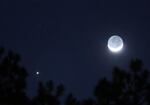
Venus and Jupiter over Rogersville, Alabama in 2012.
Claus and Sandra Martel/NASA
Looking to the western sky throughout June, Jupiter and Venus have appeared to be moving closer and closer together, and this week, you'll be able to catch the last hurrah of the planets right next to one another.
Tuesday evening, they'll appear to be a third of a degree apart — less than the diameter of a full moon, according to NASA. After Wednesday, the planets will appear to get farther apart in the sky.
Following sunset, you'll be able to see the two brightest planets to the west, near the constellation Leo.
Jim Todd with the Oregon Science Museum of Industry said Venus appears so bright because it's covered by carbon dioxide clouds, which reflect sunlight. You'll be able to see the nearby planet an hour after sunset this week and an hour before sunrise.
Jupiter will be duller, but with a small telescope, you'll be able to see the gas giant's equatorial bands, four moons and possibly the giant red spot.
It's recommended to get away from city lights for the best view. Venus will appear as the next brightest object in the sky after the moon.